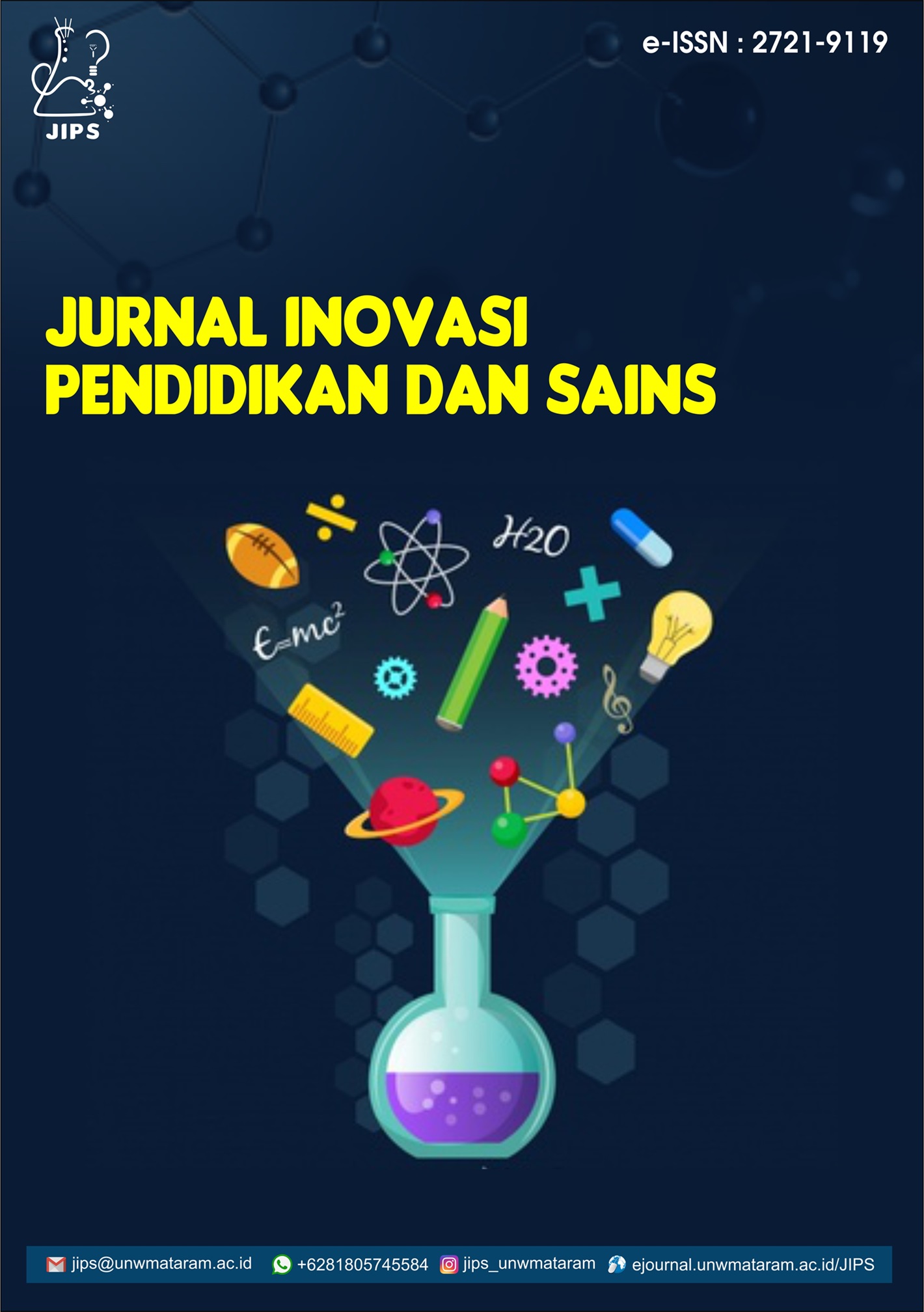THE EFFECT OF DISCOVERY LEARNING MODEL ON LEARNING OUTCOMES AND STUDENT ACTIVITY IN CLASS XII GROWTH AND PLANT DEVELOPMENT MATERIALS
Abstract
This study aims to determine the effect of the Discovery Learning model in class XII SMA Swasta Abdi Sejati Trade. The researcher also wanted to prove whether student activity and learning outcomes had significant differences before and after treatment. This research was conducted at Abdi Sejati Trade Private High School for the Academic Year of 2022/2023. From the results of the study, the average value of the experimental class using the Discovery Learning model was 83.17 with a value of 7.130, and the average value of control was 76.33 with a value of 8.087. The N-gain for the experimental class using the Discovery Learning model is g = 0.66 which is the medium category, while the N-gain for the control class is g = 0.51 which is the medium category. Therefore, the increase in learning outcomes of the experimental class was higher than that of the control class. Based on the hypothesis test obtained tcount as much as 0.444. Then it is known that the value of tcount > table. Based on the significance value, the resulting value is 0.594 which shows the significance value > 0.05. So it can be said that this research Ha is accepted and Ho is rejected or there is an effect of the use of the Discovery Learning model on learning outcomes and student activity on plant growth and development materials.
References
[2] I. Irwan and H. Hasnawi, “Analisis Model Pembelajaran Contextual Teaching and Learning dalam Meningkatkan Hasil Belajar PPKn di Sekolah Dasar,” EDUKATIF J. ILMU Pendidik., vol. 3, no. 1, pp. 235–245, Apr. 2021, doi: 10.31004/edukatif.v3i1.343.
[3] L. M. Shabrina, “Kegiatan Kampus Mengajar dalam Meningkatkan Keterampilan Literasi dan Numerasi Siswa Sekolah Dasar,” J. Basicedu, vol. 6, no. 1, pp. 916–924, Jan. 2022, doi: 10.31004/basicedu.v6i1.2041.
[4] Y. Affandi, A. Darmuki, and A. Hariyadi, “The Evaluation of JIDI (Jigsaw Discovery) Learning Model in the Course of Qur’an Tafsir,” Int. J. Instr., vol. 15, no. 1, pp. 799–820, Jan. 2022, doi: 10.29333/iji.2022.15146a.
[5] A. Putri, K. Kartini, and P. Yuanita, “Development of Learning Tools based on the Discovery Learning Model Integrating 21st Century Skills in Trigonometric Materials in High Schools,” J. Educ. Sci., vol. 4, no. 4, pp. 864–880, 2020.
[6] M. Y. Sumendra, “Aktivitas dan Hasil Belajar Peserta didik pada Implementasi Online Discovery Learning,” J. Educ. Action Res., vol. 5, no. 1, pp. 48–56, Jan. 2021, doi: 10.23887/jear.v5i1.31019.
[7] N. M. A. Suryantari, K. Pudjawan, and I. M. C. Wibawa, “Pengaruh Model Pembelajaran Inkuiri Terbimbing Berbantuan Media Benda Konkret Terhadap Sikap Ilmiah dan Hasil Belajar IPA,” Int. J. Elem. Educ., vol. 3, no. 3, p. 316, Aug. 2019, doi: 10.23887/ijee.v3i3.19445.
[8] I. Setyasih, Z. Haryanto, and S. N. Wahidah, “Pengaruh Model Pembelajaran Discovery Learning Berbasis Proyek Dengan Menggunakan Media Tour Builder Terhadap Hasil Belajar Siswa Kelas Xi Sma Negeri 1 Long Ikis,” J. Geogr., vol. 9, no. 1, p. 25, May 2020, doi: 10.24036/geografi/vol9-iss1/935.
[9] A. L. Rahmayani, “Pengaruh Model Pembelajaran Discovery Learning dengan Menggunakan Media Video Terhadap Hasil Belajar Siswa,” J. Pendidik. (Teori dan Prakt., vol. 4, no. 1, p. 59, Apr. 2019, doi: 10.26740/jp.v4n1.p59-62.
[10] P. Y. Angga Dewi, A. A. Gede Agung, and K. Rihendra Dantes, “Kontribusi Implementasi Manajemen Berbasis Nilai-Nilai Kearifan Lokal Tri Hita Karana, Kepemimpinan Pelayan Kepala Sekolah, Kecerdasan Spiritual, dan Kepuasan Kerja Terhadap Komitmen Organisasional Guru di SMP Negeri di Kecamatan Sawan Kabupaten Buleleng ,” J. Adm. Pendidik. Indones., vol. 10, no. 1, pp. 66–71, Apr. 2019, doi: 10.23887/japi.v10i1.2792.
[11] M. Al-Qoyyimah, “Implementasi Higher Order Thinking Skills (HOTS) dalam Mencapai Hasil belajar PAI kelas XI SMKN 3 Cilegon, Banten,” 2021.
[12] Sugiyono, Metode Penelitian Pendidikan (Pendekatan Kuantitatif, Kualitatif, dan R&D. Bandung: Alfabeta, 2016.
[13] H. Sugiyono, “Metode kualitatif dan kuantitatif,” Cetakan Ke-23. Alf. Bandung, 2016.
[14] P. Hayashi Jr, G. Abib, and N. Hoppen, “Validity in qualitative research: A processual approach,” Qual. Rep., vol. 24, no. 1, pp. 98–112, 2019.
[15] Y. Efendi and A. Widodo, “Uji Validitas Dan Reliabilitas Instrumen Tes Shooting Sepak Bola Pada Pemain Tim Persiwu Fc Jatiyoso,” J. Kesehat. Olahraga, vol. 7, no. 2, 2019.
[16] N. M. Janna and H. Herianto, “Konsep Uji Validitas dan Reliabilitas dengan Menggunakan SPSS,” 2021.
[17] P. I. Louangrath and C. Sutanapong, “Validity and Reliability of Survey Scales,” Int. J. Res. Methodol. Soc. Sci., vol. 4, no. 3, pp. 99–114, 2018, doi: 10.5281/zenodo.2545038.
[18] E. E. Rahayu and A. Listiyadi, “Pengembangan Alat Evaluasi Pembelajaran Berbasis Information And Communication Technologies (ICT) Pada Materi Mengelola Dokumen Transaksi,” J. Pendidik. Akutansi, vol. 2, no. 2, pp. 1–7, 2015.
[19] L. Hamimi, R. Zamharirah, and R. Rusydy, “Analisis Butir Soal Ujian Matematika Kelas VII Semester Ganjil Tahun Pelajaran 2017/2018,” MATHEMA J. Pendidik. Mat., vol. 2, no. 1, p. 57, Jan. 2020, doi: 10.33365/jm.v2i1.459.
[20] A. Nasrum, “Uji normalitas data untuk penelitian,” Jayapangus Press Books, pp. i–117, 2018.
[21] R. A. Maarif and T. Prasetyo, “Efektifitas Penggunaan Model Pembelajaran Problem Based Learning Dan Discovery Learning Berbantuan Media Gambar Terhadap Kreativitas Pada Pembelajaran Tematik Siswa Kelas 5 SD Negeri Tingkir Tengah 01 Tahun 2019/2020,” JISIP (Jurnal Ilmu Sos. dan Pendidikan), vol. 4, no. 4, 2020, doi: 10.36312/jisip.v4i4.1577.



